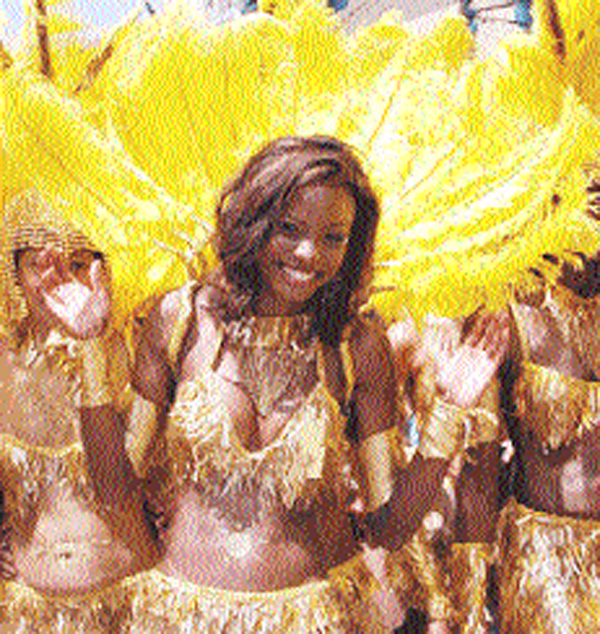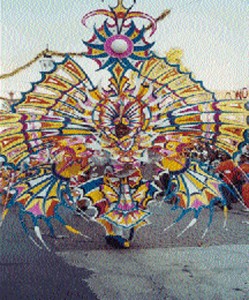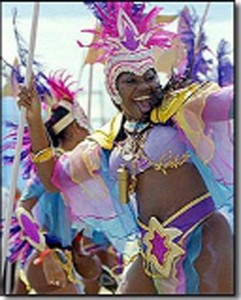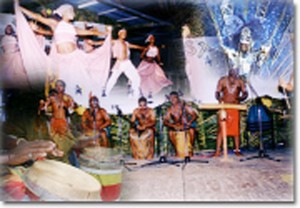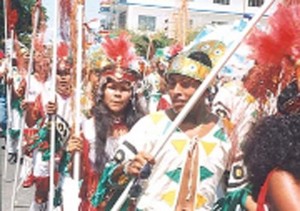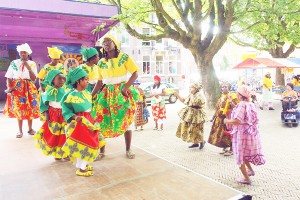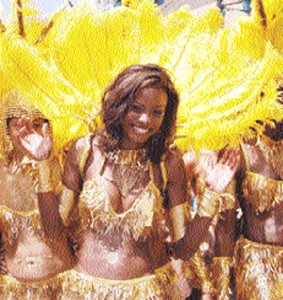Some festivals of the Caribbean
All nations celebrate sacred or secular festivals of one sort or another. Here is a sample of festivals from ten Caribbean Community nation states − The Bahamas; Barbados; Belize; Grenada; Guyana; Haiti; Jamaica; St Lucia; Suriname and Trinidad and Tobago.
The Bahamian festival of Junkanoo is a colourful parade of brightly-costumed people dancing to the rhythmic accompaniment of drums, cowbells and whistles. The celebration occurs on 26 December and 1 January, beginning in the early hours of the morning (02:00 hours) and ending at dawn.
Junkanoo’s roots can be traced to West Africa but the origin of the word ‘Junkanoo’ is unknown. The most popular belief is that it is derived from ‘John Canoe,’ an African tribal chief who demanded that he be allowed the right to celebrate with his people even after he was enslaved and brought to the West Indies. Others believe the name is from the French gens inconnus, which means the unknown people and refers to wearing disguises and, thus, being unknown.
Junkanoo probably began in the 16th or 17th century. At Christmas time, enslaved Africans were given a few days off. This allowed them to leave the plantations to be with their kindred and to celebrate the holiday with music, dance and costumes.
The five-week Crop Over festival is Barbados’s most popular and colourful celebration. With it’s origins in the 1780s when Barbados was one the world’s largest producers of sugar, there would be a huge celebration to mark the culmination of a successful sugar cane harvest, hence, Crop Over. As the sugar industry in Barbados declined, so too did the Crop Over festival and, in the 1940s, the festival ceased completely.
The festival was revived in 1974 and other elements of Barbadian culture were infused to make it the extravaganza that it has become today. It begins with the ceremonial delivery of the last canes and the crowning of the King and Queen of the Festival − the most productive male and female cane cutters of the season. The finale is the Grand Kadooment which features a carnival parade with large bands of revellers dressed in elaborate costumes to depict various themes displaying all aspects of Barbadian culture − a mixture of African survival heritage and Western modern culture.
 Belize: Garifuna Settlement day
Belize: Garifuna Settlement day
This festival commemorates the arrival of the Garifuna people in Belize in 1832. Garifuna Settlement Day is celebrated throughout the country, but especially in Dangriga, the cultural capital of Belize.
The Garifuna people are a unique fusion of two cultures – African and Amerindian. The story is that two ships transporting captive Africans were shipwrecked near to St. Vincent. The captives escaped from the sinking boat and reached the island where they were welcomed by the indigenous Caribs who offered protection. Their intermarriage formed the Garifuna people who adopted the Carib language but retained their African musical and religious traditions.
The Garifuna people rebelled against the British in 1795 and were punished by deportation to the island of Roatán off Honduras. Many Garifuna left Honduras in 1832 after a civil war there and settled in Dangriga, Belize on November 19th.
Celebrations feature traditional Garifuna and Belizean food, live punta music, games, Jonkunu dancers and, of course, a reenactment of ‘The Landing’ at Dangriga.
Practising a style of traditional drumming brought to Grenada by Africans during the era of enslavement, the Tivoli Drummers are an African-Caribbean group based in the village of Tivoli in the parish of St. Andrew, Grenada. Founded by Livingston Krumah Nelson, the son of Lemo, a great traditional drummer, the Tivoli Drummers’s mission is to spread the drum culture. The group recruited young members and taught them the art of drum-playing, dancing and singing in the traditional style.
Early in the group’s formation, it was recognised that the number of persons needed to participate and the level of organisation required to maintain the traditional style was quite difficult. Krumah then introduced choreographed drumming which makes the Tivoli Drummers unique.
The group also started several creative and experimental styles of drumming, facilitated by the manufacture of drums and the introduction of other instruments. The next logical stage in spreading the drum culture was to host an international drum festival.
Mashramani festival is observed on 23 February – Guyana’s Republic Day – to commemorate the birth of the Republic. It is the most popular and colourful of all the festivals.
The word Mashramani is derived from the Arawak indigenous language and in translation means “the celebration of a job well done”. It refers to a special event which brings people together after some enterprise.
The biggest celebration is usually in Georgetown, the capital, where spectacular costume competitions, float parades, masquerade bands and dancing in the streets to the accompaniment of steel band music and calypsos, take place. Masquerades frequent the streets performing dance routines, a reminder of Guyana’s African heritage. Calypso and Chutney singing competitions with their witty social commentaries are another integral part of the festival and this culminates in the coronation of a King or Queen.
As a national holiday, Mashramani is celebrated in a semi-official way in all ten Regions of Guyana with flag-raising ceremonies or sporting events.
Haiti: Rara Festival
Rara bands march the rural roads of Haiti every year, beginning during Lent and culminating on Good Friday. A Rara band comprises members of the congregation of a particular Houngan or Mambo or, more frequently, of a Makaya Bokor or Sanpwel President.
One folk tale claims that Rara bands represent the Jews who mocked Christ on his road to Golgotha. In reality, however, a Rara band exists to demonstrate the strength and wealth of a congregation, the number of able-bodied and desirable men and women the group has, and the richness of the costumes they are able to afford. It also demonstrates the strength of the fierce lwa of the group, which protect group members from the lwa of other groups.
Rara band members sing their songs and dance in characteristic manner. The women form groups under the supervision of a leader, running out and back in single file, and forming more complex patterns as they double back on themselves.
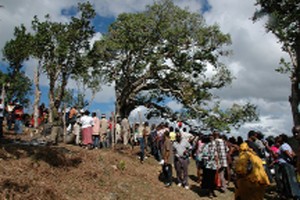 Jamaica: The Accompong
Jamaica: The Accompong
Maroon Festival
The blowing of the Abeng, the playing of the Maroon drums and the traditional march to the Kindah tree are just some of the ways Jamaica pays tribute to the ancestors of the Maroons, the descendants of the enslaved Africans who were freed by the Spanish and fled to Jamaica’s untouched South Coast in pursuit of freedom, and who live there to this day.
This celebration commemorates the birthday of Captain Cudjoe, a Maroon warrior, who defeated the British Army and later brokered a peace treaty with the British in 1738, which guaranteed their freedom and significant land holdings. Included in this historic treaty are the founding principles that, to this day, govern the day-to-day activities of the people of Accompong, a nation within a nation.
The Accompong Maroon Festival features traditional dancing, singing, Maroon feast and ceremonies. Maroons from several villages across the island attend to experience the celebration and the Maroon community’s unique sub-culture.
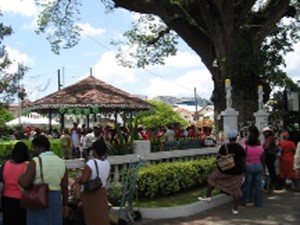 St Lucia: Rose Festival
St Lucia: Rose Festival
The Rose festival of St Lucia, initially of religious origins, is part of the Feast of Saint Rose de Lima. It honours this regal flower with great pomp and ceremony that includes a royal kingdom complete with king, queen, dignitaries and subjects.
Celebrated all over St Lucia, official Rose proceedings take place on 30 August, but this important event demands careful preparation. Every Saturday night for a month before the festival, people meet for all-night singing and dancing sessions and raise money for the new year’s costumes.
At each meeting, they dress up in last year’s fancy dress. No-one is allowed to see the current year’s costumes before the big day. Most participants go to church for mass before parading through the streets and to the main hall for the Grande Fête.
The singing is led by the shatwel (lead singer), drums start beating, guitars start playing and the shak-shaks (similar to maracas) start shaking, to start the partying that it continues well into the next day.
Keti Koti refers to the termination of the enslavement of Africans and is celebrated on 1 July as a national holiday in Suriname. Keti Koti refers to the fact that ‘the chains have been broken.’
A standard feature of the 1st of July celebration is a parade of kotomisi on Independence Square. A kotomisi is a woman (misi) wearing the national creole costume (koto), a voluminous form of dress designed by enslaved women to hide their figures from the attention of lustful white planters. This dress has become the virtual symbol of the free Surinamese woman and, thus, is associated with the end of enslavement.
The Dutch were the last Europeans to abolish slavery and the enslaved Africans in Suriname had to work for a further ten years after 1863. Indeed, they had been working on the Dutch-owned plantations from the 17th century onwards. Many, called maroons, fled to the jungle due to chronic maltreatment.
Major events in Paramaribo include celebrations in the Palm Gardens and the Kotomisi parade in Independence Square
Trinidad and Tobago’s carnival had its roots in West African festivals. Its transfer to the Caribbean came through French observances in which masks were donned. When the use of drums and religious practices had been outlawed, the Africans found novel ways to pass on their heritage by adding singing, dancing, and music.
Carnival is celebrated two days before Ash Wednesday at the start of the Christian season of Lent. The festival is associated with the Roman Catholic idea of carne vale (farewell to meat) during which devotees were forbidden to eat meat.
African dance and music traditions transformed the early carnival celebrations in the Americas, as African drum rhythms, large puppets, stick fighters, and stilt dancers began to make their appearance in the carnival festivities. For African people, carnival became a way to express their power as individuals, as well as their rich cultural traditions. After Emancipation in 1838, freed Africans began to host their own carnival celebrations in the streets. These evolved into more elaborate forms as time went by.

